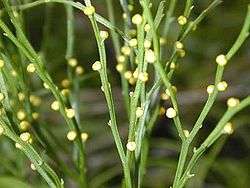Psilotum
| Psilotum | |
|---|---|
 | |
| Closeup of Psilotum nudum | |
| Scientific classification | |
| Kingdom: | Plantae |
| Division: | Pteridophyta |
| Class: | Psilotopsida |
| Order: | Psilotales |
| Family: | Psilotaceae |
| Genus: | Psilotum |
| Species | |
| |
Psilotum (whisk fern) is a genus of fern-like vascular plants, one of two genera in the family Psilotaceae, order Psilotales, and class Psilotopsida (the other being Tmesipteris). The name of the genus is from Greek psilos = bare, referring to the lack of the usual plant organs, such as leaves.[1]
Species and distribution
There are two species, Psilotum nudum and Psilotum complanatum, with a hybrid between them known, Psilotum × intermedium W. H. Wagner.
The distribution of Psilotum is tropical and subtropical, in the New World, Asia, and the Pacific, with a few isolated populations in SW Europe. The highest latitudes known are in South Carolina, Cádiz province in Spain,[2] and southern Japan for P. nudum. In the U.S., P. nudum is found from Florida to Texas, and P. complanatum in Hawaii.
Relation to ferns
Psilotum superficially resembles certain extinct early vascular plants, such as the rhyniophytes and the trimerophyte genus Psilophyton. The unusual features of Psilotum that suggest an affinity with early vascular plants include dichotomously branching sporophytes, aerial stems arising from horizontal rhizomes, a simple vascular cylinder, homosporous and terminal eusporangia and a lack of roots.[3] Unfortunately, no fossils of psilophytes are known to exist. A careful study of the morphology and anatomy suggests that whisk ferns are not closely related to rhyniophytes, and that the ancestral features present in living psilophytes represent a reduction from a more typical modern fern plant. Significant differences between Psilotum and the rhyniophytes and trimerophytes are that the development of its vascular strand is exarch, while it is centrarch in rhyniophytes and trimerophytes.[4] The sporangia of Psilotum are trilocular synangia resulting from the fusion of three adjacent sporangia,[4] and these are borne laterally on the axes. In the rhyniophytes and trimerophytes the sporangia were single and in a terminal position on branches.[5]
Molecular evidence[6] strongly confirms that Psilotum is a fern and that psilophytes are sister to ophioglossoid ferns.
Gametophyte
The gametophyte of Psilotum nudum L. Beauv. (P. triquetrum Swartz) is unusual in that it branches dichotomously, lives underground and possesses vascular tissue.[7] The nutrition of the gametophyte appears to be myco-heterotrophic, assisted by endophytic fungi.[8]
References
- ↑ Etymology of Psilotum
- ↑ "Psilotum nudum" (PDF). Atlas y Libro Rojo de la Flora Vascular Amenazada de España.
- ↑ Gifford, Ernest; Adriance Foster (1989). Morphology and Evolution of Vascular Plants, Third Edition. New York: W.H. Freeman and Company. ISBN 0716719460.
- 1 2 Bell, P.R.; Hemsley, P.R. (1992). Green plants, their origin and diversity (second ed.). Cambridge, U.K.: Cambridge University Press. ISBN 0521646731.
- ↑ Stewart, W.N.; Rothwell, G.W. (1993). Palaeobotany and the evolution of plants (second ed.). Cambridge, U.K.: Cambridge university press. ISBN 0521382947.
- ↑ Qiu, Y-L and Palmer, J (1999) "Phylogeny of early land plants: insights from genes and genomes." Trends in Plant Science 4(1), 26-30
- ↑ Holloway, J.E. (1939) The gametophyte, embryo and young rhizome of Psilotum triquetrum Schwarz. Annals of Botany 3, 313-336
- ↑ Manton, I. (1942) A note on the cytology of Psilotum with special reference to vascular prothalli from Rangitoto Is. Annals of Botany 6 283-92
| Wikispecies has information related to: Psilotaceae |
| The Wikibook Dichotomous Key has a page on the topic of: Psilotaceae |